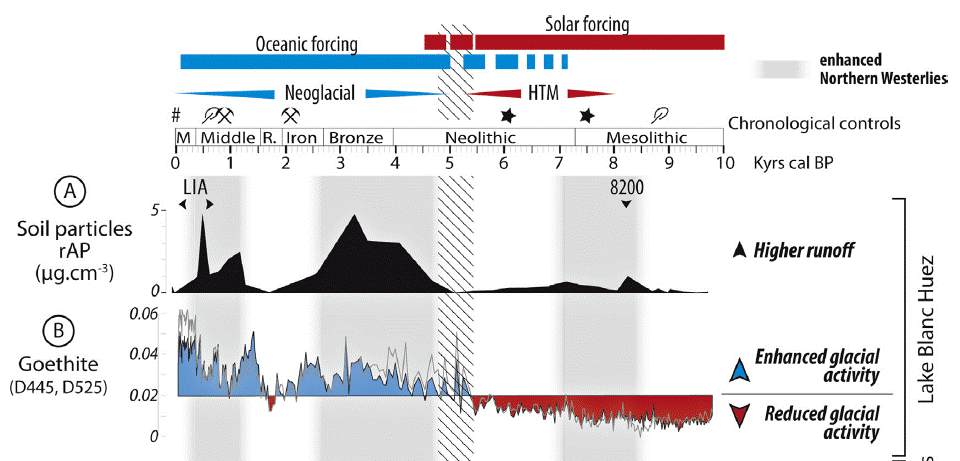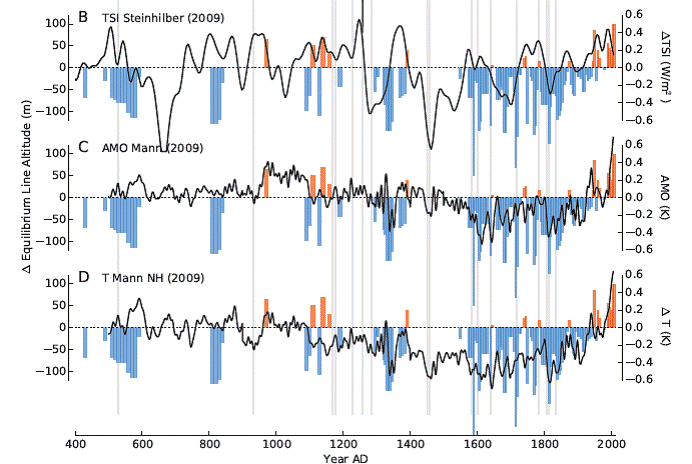New studies confirm: Glaciers in the Alps already had “fevers” during the Roman and Medieval warm periods
By Sebastian Lüning and Fritz Vahrenholt
(Translated, edited, condensed by P Gosselin)
Everywhere activists and climate alarmists are claiming climate change is happening faster than ever and that the earth is dangerously approaching a tipping point. For example Greenpeace likes to say that the glaciers are actually the “fever thermometers” measuring the health of the planet and that their melting tells the story of inevitable total meltdown. For example in the Alps glaciers have receded by almost a half since the year 1850. Greenpeace writes:
Foremost since the 1990s the rate of melt has increased and is expected to rise over the coming years: Today’s melting is being caused by greenhouse gas emissions from 30 years ago.”
But is glacier melt really something new and unexpected?
Greenpeace uses the Alps as a telltale example. It is precisely there that we want to carry out a fact-check. Firstly one has to wonder why the glacier melt in the Alps began already way back in 1850 – when anthropogenic CO2 couldn’t have played any significant role. This was already determined by geologist Albert Schreiner in 1997 in his textbook “Introduction to Quatenary Geology“ (p. 188, Fig. 91).
One finds even greater factual headaches when going back through the history of the climate for the last several thousand years. Already in earlier articles we wrote that the Alps glacier melted considerably during earlier warm periods.
The melt phases during the Medieval Warm Period 1000 years ago and during the Roman Warm Period 2000 years ago have been well documented (see our blog articles here and here. In April 2014 two more additional papers were published, which impressively confirmed the natural glacier dynamics.
In the Quaternary Science Reviews appeared a paper authored by a team led by Anaëlle Simonneau of the French University Orléans, which reconstructed the glacier movements in the French Alps over the last thousands of years. Here the scientists documented several glacier melt phases, which unsurprisingly included the Roman and Medieval warm periods (Figure1). What follows is an excerpt from the abstract:
Holocene palaeoenvironmental evolution and glacial fluctuations at high-altitude in the western French Alps are reconstructed based on a multiproxy approach within Lake Blanc Huez (2550 m a.s.l.) drainage basin. […] periods of reduced glacial activities dated from the Early Bronze Age (ca 3870–3770 cal BP), the Iron Age (ca 2220–2150 cal BP), the Roman period (ca AD115–330) and the Medieval Warm Period (ca AD760–1160).”

Figure 1: Reconstruction of glacier activity in the French Alps. The glacier advances are shown in blue and melt periods in red. The scale is in 1000s of years before today. The Medieval Warm Period is at 1 (=1000 years before today), the Roman Warm Period is at 2 (=2000 years before today). Moreover: In the time from 6000 to 9000 years before today there was massive glacier melting. Source: Simonneau et al. 2014.
A second paper comes from Martin Lüthi of the University of Zurich, appearing in The Cryosphere. It contains a reconstruction of the Alps glacier history for the last 1600 years. Interestingly the seven examined glaciers show conditions during the Medieval Warm Period that were similar in length as today (Figure 2).

Figure 2: Length changes in Alps glaciers over the past 1600 years. The blue negative vertical bars depict advancing glaciers while the red bars represent retreating glaciers. From Lüthi 2014.
Despite these proven natural glacier cycles, Greenpeace Greenpeace predicts an early death and terrible consequences for the Alps:
Glacier scientists anticipate an almost complete melting in this century. There are 5000 glaciers in the Alps. When many of them are permanently melted, there could be a sensitive collapse in the water supply. Glaciers store drinking water.
A scary theory. However the glaciers are ignoring all the catastrophe predictions and even started to grow once again in 2013, see here. And in the Swiss Alps snow amounts since 2000 have unexpectedly been on the rise.
A look back at the climate history reveals that the alarmist stories for the Alps are nothing but a tempest in a teapot. It’s all happened before. Obviously the fear-mongers have failed to look beyond 150 years ago. How much longer can they keep this up without serious science pushing back?
Quartiary





There was a scientist – I forget the name – who on being told that observers had discovered that the glaciers were retreating, asked “And what did they find?”
Offhand, I can recall that in northern Russia, they found the stumps of trees which were growing about 1,000 years ago; in the Tirol, they found the silver mines which once financed the Holy Roman Empire; in Greenland they found the remains of the Viking farms.
Doubtless, others here could add to the list.
http://www.livescience.com/39819-ancient-forest-thaws.html
and
http://www.sci-news.com/biology/article01112-400-year-old-plants-moss.html
Has the Grindelwald glacier in Switzerland melted back to its known length in 1205 (when it destroyed a water channel)?
I saw in the last year (or two) that the remains of a forest covered in 1240 had been exposed.
Lots of factors have caused Alpine glacier retreat, it happens when the earth warms – naturally.
The Alps, is an arc of mountains straddling some of the most intensively industrialized regions on the planet.
Europe’s industrial revolution powered the world from circa 1860’s – onwards through to the present day.
Of which – the pollution [particularly soot/black carbon] is a known cause of glacial melt, from the chimneys and exhausts of [steam once] trains, engines, vehicles and factories from across the Po valley in Italia, to the Franch industrial heartlands of Alsace-Lorraine on the coalfields of the Saar – and to the Ruhr and Rhineland of Germany.
Precipitation variations – decreasing amounts – also cause ice retreat as much as does, the summer sunshine.
Even if, the glaciers did all melt, the rain would still fall, the lakes would be filled and rivers will still flow from the dome of the Alps…….crisis, what crisis?
Without doubt man has caused the Alpine ice to diminish but to blame it all on so called “man made CO2 induced warming” is a specious lie – that only the alarmist ecoloons could stoop to.
Next….
“Without doubt man has caused the Alpine ice to diminish”
I do not think that Alpine ice is in any way impressed by the piddly undertakings of a few men in the valleys doing something. (Mostly preparing to be able to survive the next winter)
“When many of them are permanently melted, there could be a sensitive collapse in the water supply. Glaciers store drinking water.”
I will add other uses – irrigation, washing your SUV, and making beer!
This sort of statement is odd. I’ve seen such before. Anyway, the glacier has to melt to get the water to make the beer. It seems to me the opposite will be the real problem. If there is a cold period and ice mass increases, one could still say “Glaciers store drinking water” but that is a bad thing – correct? No fresh mountain water, no beer! What about the beer?
Greenpeace has obviously never heard of ‘Ötzi – the Iceman’.
http://www.iceman.it/en/node/226
“Quartiary” Geology? Should rather be Quaternary Geology.
Quarternary…………………..Tertiary
= Quartiary?
= neologism.
*******************************************************************************
Dirk, man [and his Soot] – has affected glacial melt but only in a minor and incidental effect.
How could Hannibal have got his elephants over the Apls if they had been blocked by glaciers?
I have yet to see any mention of the ice cover on the arc. tic ocean at the end of this summer’s melting season. Has it continued to expand?